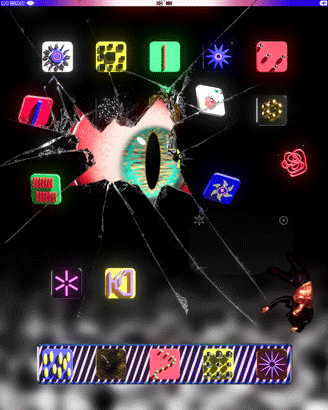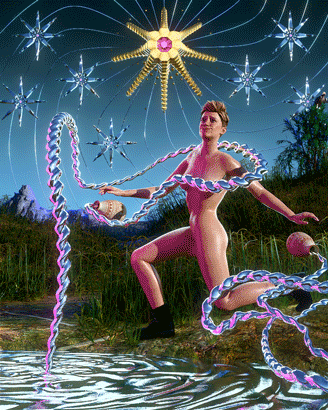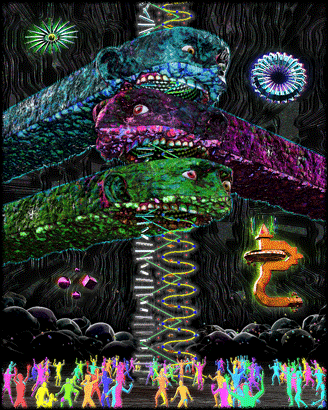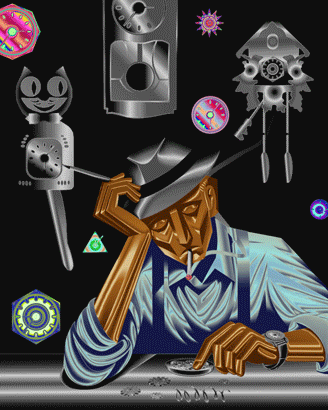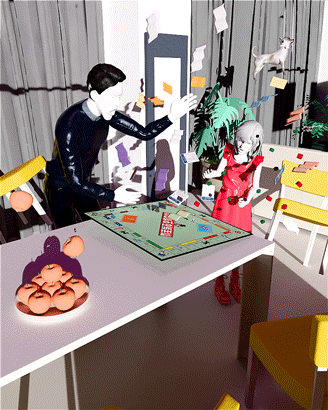Friction with the Machine (Issue #42)
An interview with artist Psychofuturist
“welcome to SEE” (image credit: Psychofuturist)
1/1: Please introduce yourself.
Psychofuturist: Hey, hi! This project is called Psychofuturist, and I’m the one running it. For this project, my name isn’t really relevant, so you can just call me Psychofuturist.
I prefer to keep a certain level of anonymity with my work, as this isn’t my only project in the space. Anonymity gives me the freedom to create without expectations. While Psychofuturist may not be my main focus, right now, I’m dedicating a lot of time and effort to it. I’ve been active in Web3 since 2021 and have been involved in various projects, but I'd like to keep my other ventures and identity somewhat blurry.
1/1: What art have you been working on lately?
Psychofuturist: I try to create one piece a day. It’s not always possible, but I like the idea of pushing myself daily.
Lately, I’ve been drawn to making small collections centered around specific concepts. I recently completed a series of six pieces focused on different screens—exploring various prototypical screens, like an iPad or desktop monitor, and playing with the composition of the expected elements inside them. I’ve done a few other collections in a similar vein, one about sights, another about kids playing, and now I’m working on a series about my favorite machines in science fiction.
1/1: Can you describe your workspace and how it influences your art?
Psychofuturist: I work on a laptop. I like the flexibility of using it at my desk with speakers or taking it to a café with headphones. Laptops evolved alongside me as I was growing up, so I feel like they’re the gadget for my generation of artists.
I try to keep things simple, which is why I prefer the laptop. I can just throw it in a backpack and go. I aim to minimize everything else in my life as well.
“perfectly ultimate great look” (image credit: Psychofuturist)
1/1: What tools do you use? Do you work with any special devices or tools unique to your creative process?
Psychofuturist: I don’t think I use anything special, or at least not anything worth writing home about. I mainly use Blender, and I've developed a lot of custom key bindings and scripts for faster Blender sketching tailored to my specific use case. I created these scripts with the help of large language models, and I use them daily for everything. I know that might sound a bit dull, but it’s a core part of my process.
Outside of that, I use Blender with a bunch of add-ons, along with software like After Effects, Photoshop, and sometimes drawing apps like Procreate or Aseprite for pixel work. I keep things simple and rely heavily on presets and plugins. For this project, I also use pre-made models and often buy assets like that.
Before diving into the digital tools, I sketch my ideas in a notebook—which is sadly about to be full. Honestly, the sketches are probably the most important part of my process, even if they’re a bit atrocious!
1/1: How would you describe your aesthetic?
Psychofuturist: I like to aim for that middle ground where something is iconic and has recognizable elements, but it’s not predetermined. It connects with you but leaves you space for your own interpretation. If something makes that kind of connection in my mind, that’s what I pursue. I guess that’s how I’d describe the aesthetic I’m drawn to.
On a technical level, I constrain myself to GIF format, 50fps, and 819x1024px resolution. It’s been my jam, I’ve optimized everything in my workflow around it, and I love it. This works across different platforms—social media, phone screens, big screens, etc.
“everything seems so small now” (image credit: Psychofuturist)
1/1: How do you approach developing an idea into a finished piece? Can you walk us through your workflow?
Psychofuturist: I try not to overthink things—at least, not for this project. My main inspirations lately are what I’m reading (like the Bible—not for any specific religious endeavor but because it’s a book full of powerful imagery; some classic works by Hemingway; and Stanislaw Lem’s famous novels), and what I’m listening to (today it was Juan Gabriel, 1tbsp, and The Kinks). I also have folders of cool images I’ve collected from the internet, which I browse occasionally for color and composition references.
In other projects, I usually put a lot of thought into creating a consistent style and lore, building a whole world around the images. But for this project, it’s more impulsive. If I encounter something with a “cool” vibe or a specific feel, I just go for it. Ironically, this more spontaneous approach has worked better than some of my more carefully planned projects.
1/1: Can you describe a typical day in your artistic practice, including any rituals or habits?
Psychofuturist: There are definitely some rituals. In front of my house, there’s a local market that’s amazing. I go there every day for some orange juice or something similar, then have breakfast (usually huevos rancheros). After that, I read a bit or watch some YouTube videos, take walks, chat with my girlfriend, meet friends, or catch a movie. If an idea or technique comes to mind along the way, and it feels interesting, I dive right into it.
I try to optimize everything—do it fast, turn ideas around quickly, drop new work near daily. This way, I get energy from seeing ideas through to completion. Then I can avoid feeling stuck and keep living my calm, boring, nice life.
1/1: How do you feel about the impact of generative AI on the creative process? Do you have a favorite AI tool?
Psychofuturist: I use some generative AI, sometimes, mainly for images that are hard to find through Google searches—like the eyes of an anime-style girl looking to the left (yes, I already sound like I’m writing a prompt). I know I've seen an image like that somewhere, and I could probably draw it myself, but I don’t want to spend that much time on it, and I can’t seem to find the right one on Google. So, I turn to generative AI tools to help me get there.
I’ve found Bing, despite its flaws, to be the most "iconic," if I can use that word—it often gets the closest to what I’m envisioning from my prompts. That’s maybe my favorite tool for this purpose, crappy as it may sound.
“the star” (image credit: Psychofuturist)
1/1: Is there anything you consciously reject or struggle against in your work?
Psychofuturist: Friction with the machine, always. Friction with software, figuring out how to pour the most ideas into an image as quickly as possible. That’s why I try to optimize everything. But at the same time, that friction is what makes working on the computer—or any medium—interesting.
I also make music, and for me, friction in music is the key part of everything. You can look at the music movements of the last century with that eye: punk is music for people who didn’t want to learn to play their instruments; electronic music is for those who don’t know or can’t afford physical instruments; trap music is for rappers who don’t want or don’t know how to rap quickly. Every constraint can create cool results.
1/1: Are there any specific works of art (music, literature, film, etc.) that inspire or have significant meaning to you in your artistic practice?
Psychofuturist: The ones I mentioned earlier are what I’m currently reading: the Bible, Hemingway, and Stanislaw Lem. I also enjoy Roberto Bolaño, and I’m trying to revisit the poetry of Nicanor Parra, though it’s tough sometimes.
In music, besides the artists I mentioned before (Juan Gabriel, 1tbsp, and The Kinks), I recently discovered a genre from Tanzania called "singeli," thanks to my friend David V Nun. It’s super-fast electronic music, and it's some of the most creative music I’ve come across lately. It has me in awe.
1/1: How do you come up with titles for your work?
“Masked ⁜ Head ⁜ Valley” (image credit: Psychofuturist, David V Nun)
Psychofuturist: Most of my titles come from books, films, random phrases someone says, or descriptions of odd situations. I also pull from scientific or specialized terms.
A few titles come from my own thoughts—things I think can create an interesting dialogue with the piece, encouraging anyone who reads the title to see the work from a certain perspective.
I keep lists of anything interesting I read, think, or hear.
1/1: What draws you to NFTs? Do you have a presence in the 'traditional' art world?
Psychofuturist: The lack of interest from the traditional art world is what drew me into NFTs initially. The idea of making a living from creating GIFs is one of the coolest things I can imagine, so that’s the main appeal—being able to support myself through this medium.
I think that’s the real revolution of NFTs. There were digital artists exploring digital ownership before—Rafael Rozendaal, for example, had a vast body of work about it. We, the artists, were friends before. I met a lot of digital artists before because of the internet, sharing stuff. But there was no money, no real value attached to it. Musicians rightly complain about how little they earn from streaming services, but in digital art, there wasn’t even that. A viral GIF or JPEG didn’t come with any distribution, let alone payment. NFTs changed that, and I think it’s amazing.
1/1: For someone just getting into NFTs, what advice would you offer?
Psychofuturist: I don't know if I’m in the position to give advice. I would actually appreciate some advice in that matter lol.
If you enjoy doing digital creative stuff and putting it out there, try to just make an NFT project— doesn't even have to be under your own name—and try to make it take off.
I think it's an amazing platform to test ideas, share with artists, collectors, test your commitment, see if you're having fun.
The worst that can happen is you leave with a few Tezos and a couple new friends.
“you sold my soul twice” (image credit: Psychofuturist)
1/1: How do you approach the balance between accessibility and exclusivity in selling your work? (in terms of open editions versus 1/1s, etc.)
Psychofuturist: I think all my work is accessible in the same way, if you look at it through the idea of the internet being the distribution channel. You can watch it the same as someone who owns the token, and I think that’s the beauty of NFTs—the works are always public.
In terms of editions, it’s just a feeling, I guess. Some works feel like they should have more editions, some less. It’s really about trying to make it exciting for everyone. I try to set a minimum so I get enough to keep creating, but other than that, I just play it by ear.
1/1: Who are some of your favorite artists in the NFT space?
Psychofuturist: Right now, to name three, I can say that David V Nun, Neurocolor, and Sabato are doing killer work.
1/1: What are you working on next?
Psychofuturist: I plan to make at least three more machines in my sci-fi machines series, and then, I don’t know—probably another series. Right now, I like the idea of doing a tarot, so we’ll see. :)
1/1: Could you show us some of your favorite work you’ve done and tell us what it means to you?
Psychofuturist: Sure! I went back through my pieces and picked three that caught my attention the most at first sight:
“Watchmakers HATE HIM” (image credit: Psychofuturist)
I like the technique in this piece, especially the shape of the clocks. I like how they fit together even though they came from very different references. And I like that he is so sad, poor guy.
“it's not fair if i can't cheat” (image credit: Psychofuturist)
I love the dynamic in play here. I found it very silly to have just an adult and a little girl playing Monopoly, and then the adult storms off in anger. Monopoly is a very bad game, in my opinion—it brings out the worst in a lot of people.
“how to make love in the 4th dimension” (image credit: Psychofuturist)
This is one of the pieces I’ve put more time into, and I like how it turned out technique-wise. I also love love, so everyone wins.
1/1: We commissioned a piece from you, “i know my fish is somewhere.” Can you tell us about it?
Psychofuturist: Sure! I don't know if it's worth it to give the whole game away, but well, if you're interested, it comes from The Old Man and the Sea, one of my favorite books. It's really elements of the parts of the book I love the most; in a way, it's what I would do for a movie poster or a book cover. But now that I think about it, I don't know if I could bear having to put letters on top of it lol, so maybe not the best use case. But yeah, for me it's about the dialogue between the fish and the old man, and in a way, about how I like to imagine the whole book as a movie in that pixelated style. Wouldn't that be great? I would say so!
“i know my fish is somewhere” (image credit: Psychofuturist)


